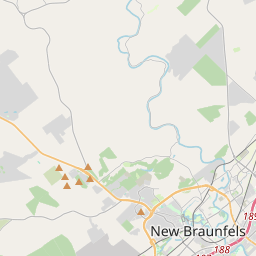New Braunfels
Historical marker location:






Founded on March 21, 1845 by Carl, Prince of Solms-Braunfels, Commissioner-General of the Society for the Protection of German Immigrants in Texas. Named after Prince Solms' estate, Braunfels, on the Lahn River in Germany. Its permanence was assured by John O. Meusebach, the second Commissioner-General. The first colonial officials were Jean J. Von Coll, bookkeeper; Nicholaus Zink, surveyor; Theodore Koester, physician. L.C. Evenberg served as pastor and Hermann F. Seele as teacher. Comal County was created on March 24, 1846, by an act of the first Legislature of Texas. The New Braunfelser Zeitung, oldest German newspaper in Texas, began publication on November 12, 1852, with Ferdinand Lindheimer as editor. The first Staatssaengerfest was held at New Braunfels on October 16, 1853, and the first special tax for school purposes levied and collected in Texas was voted by New Braunfels on March 17, 1856.
Erected by the State of Texas 1936 with funds appropriated by the Federal Government to commemorate one hundred years of Texas independence
As one of the most visible programs of the Texas Historical Commission (THC), historical markers commemorate diverse topics in Texas history, including: the history and architecture of houses, commercial and public buildings, religious congregations, and military sites; events that changed the course of local and state history; and individuals who have made lasting contributions to the state, community organizations, and businesses.
The Battle of San Jacinto fought on April 21, 1836, was the decisive battle of the Texas Revolution, and led to the capture of Santa Anna and the end of the conflict.
In the early 19th century, German immigrants began to arrive, attracted by the fertile land and opportunities for a better life. These settlers established small farming communities and brought with them their language, traditions, and expertise in agriculture and craftsmanship. The town of New Braunfels was founded in 1845 by Prince Carl of Solms-Braunfels, becoming the first German colony in Texas.
The mid-19th century saw significant growth and development in Comal County, with the construction of schools, churches, and businesses. The area became known for its thriving agricultural industry, with farmers cultivating crops such as cotton and corn. The arrival of the railroad in the late 19th century further spurred economic growth and provided easier access to markets.
Throughout the 20th century, Comal County continued to evolve and adapt to changing times. The county's strong German heritage remained at the forefront, celebrated through events like Wurstfest, a German sausage festival. The tourism industry also grew, with visitors flocking to the county's natural attractions, such as the iconic Guadalupe River and historic Gruene Hall, Texas' oldest continually operating dance hall.
Today, Comal County is a vibrant and thriving community, blending its rich history with modern amenities and a strong sense of pride in its cultural heritage. With its beautiful landscapes, strong economy, and warm Southern hospitality, Comal County continues to be a desirable place to live and visit.
Comal County Timeline
This timeline provides a condensed summary of the historical journey of Comal County, Texas.
- 1846 - Comal County established as one of the original 23 counties in the state of Texas
- 1847 - Settlement begins in the area with the founding of New Braunfels
- 1850 - Comal County's population reaches 2,013
- 1861-1865 - County residents actively involved in the American Civil War
- 1870 - Completion of the first railroad through Comal County
- 1885 - Jacob's Well, a natural artesian spring, becomes a popular tourist attraction
- 1920s - Economic growth in Comal County, driven by agriculture and manufacturing industries
- 1941-1945 - County residents contribute to the war effort during World War II
- 1968 - Canyon Lake, a reservoir on the Guadalupe River, is completed
- 1990s - Rapid population growth and urban development in Comal County
- 2007 - Construction begins on the controversial Trans-Texas Corridor project